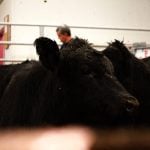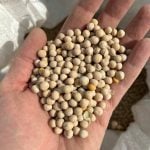“In the long term, consumers are going to see much higher meat and poultry prices because the economic conditions are causing livestock producers to cut production.”
– JIM ROBB
Amer icans are eat ing more hamburgers and fewer steaks as the economy wallows in recession, and that has led to huge losses at U. S. feedyards that fatten the cattle for steaks.
Each week $100 million is lost as feedyards from Nebraska to Texas sell cattle at well-below production costs.
The losses have been so bad for so long that economists predict many feedyards will either close or shrink. That, they claim, will mean higher-priced beef for consumers when the economy does recover.
Read Also

Finally getting paid for sustainable farming?
Alberta project says they might have a line on a workable ecosystem credit model to reward farmers for sustainability, and Manitoba might be next
The United States is somewhat unique amid global beef producers in that most of its cattle are fattened in feedyards on grain and other nutrients, as opposed to grazing on lush pastures.
These grain-fed cattle produce the juicy steaks preferred by gourmands, fine-dining restaurants and cookout enthusiasts.
“The losses have been so large in the first three months of 2009 that it is going to be months and months and months until feedyards even have a chance to recover those losses. It is depressing,” said Jim Robb, economist at the Livestock Marketing Information Center.
As the global economy soured, many consumers around the world shifted away from white tablecloth restaurants to fast-food hamburger chains or to at-home dining.
“I think what people are missing is it is not a drop in beef demand so much, as it is what sort of beef people are eating,” John Josserand, president of AzTx Cattle Co., said of the change in beef consumption. “People are eating at McDonald’s instead of Outback.”
The hamburger that consumers are now eating comes from beef cows or dairy cows that are raised on grass, and not steers.
RESTAURANT, SUPERMARKET DEALS
Restaurants are trying to peddle the beef via promotions and discounts, but it has been hard.
The Outback Steakhouse chain, owned by OSI Restaurant Partners LLC, said this month it will offer more-affordable menu items of 15 new entrees under $15.
Such promotions are needed to bring in consumers, said Harry Balzer, vice-president of NPD Group a consulting firm.
“Going out to restaurants just because you want to use a restaurant is declining. Going out to a restaurant because you found a deal is up six per cent,” said Balzer.
Supermarkets also have been promoting beef, but food consultant Len Steiner
of Steiner Consulting said sales have not been enough to reduce inventory and help cattle producers.
As a result, feedyards are losing $200 or more on every head of cattle they sell. At the current sales pace of about 550,000 cattle each week, that equates to industry-wide losses of about $110 million a week.
“It is going to take at least until mid-2010 to make back the losses of the first three months of 2009,” said Robb. “We have some people, who are going to go out of business. This is taking a huge toll on the U. S. cattle-feeding business.”
“There are feedyard closures. There is a large amount of feedyards for sale. There are a lot of people exiting the business,” said Josserand.
There were 11.29 million cattle in U. S. feedyards as of Feb. 1, down six per cent from a year earlier, and the lowest supply for that date in five years, U. S. Agriculture Department data show.
LESS MEAT, HIGHER PRICES LATER
“It is about consumer demand for beef. When will that turn around? I would say that fundamentally, an uptick in demand for beef probably does not come until early 2010,” said LMIC’s Robb.
As the cattle supply shrinks, so will the beef supply, which may be a concern later when a recovery takes hold and more consumers return to finer restaurants and grab the best cuts of meat at supermarket counters.
“In the long term, consumers are going to see much higher meat and poultry prices because the economic conditions are causing livestock producers to cut production,” said Robb.
Chicken producers have aggressively reduced flocks because of high feed costs and low meat prices. Pilgrim’s Pride Corp., one of the largest chicken producers, was forced into bankruptcy.
Hog producers have also cut back. Smithfield Foods Inc., the world’s largest hog and pork producer, has cut its sow herd by 10 per cent. Sows produce the young pigs that are fattened for slaughter.
“The supply fundamentals are such that if we can get any relief on the demand side, cattle prices will respond pretty quickly,” said Derrell Peel, agriculture economist at Oklahoma State University.














